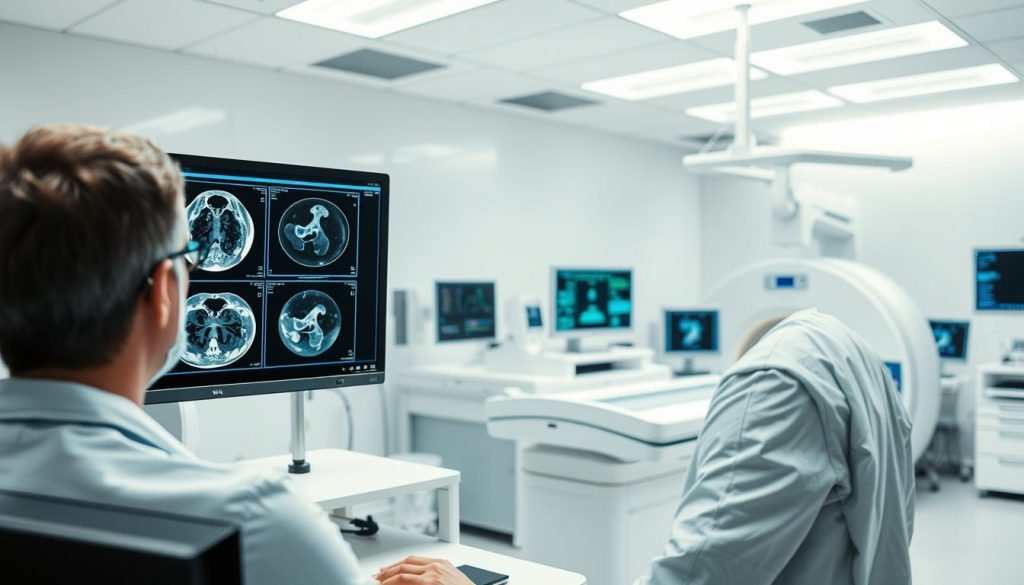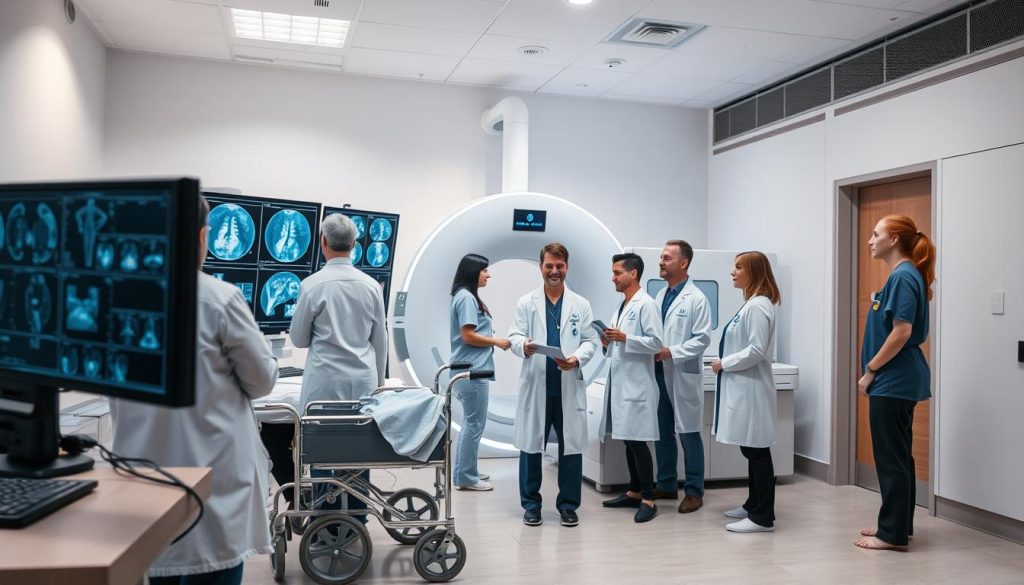Diagnostic radiology uses medical imaging to see inside the body, helping doctors find and treat health issues. This field combines advanced technology like X-rays, CT scans, and MRI scans to provide clear images of bones, organs, and tissues. These tools let healthcare teams make faster, more accurate diagnoses.
Modern diagnostic radiology improves patient care by reducing the need for invasive procedures. It plays a key role in spotting conditions early, from broken bones to serious illnesses. New technologies keep making imaging safer and more precise, leading to better health outcomes.
Key Takeaways
- Diagnostic radiology uses medical imaging to detect diseases and injuries.
- Imaging techniques like X-rays and MRIs help doctors create treatment plans.
- Early diagnosis through imaging reduces risks and speeds up recovery.
- Technology advances make scans faster and more detailed than ever.
- Diagnostic radiology improves accuracy while minimizing patient discomfort.
For More Information Please Contact Proprietor Mr. Abdul Alim, Cell – +8801711994334.
What is Diagnostic Radiology?
Diagnostic radiology is a medical field that uses imaging to uncover health issues inside the body. These diagnostic procedures help doctors make precise decisions about patient care. By capturing detailed images, radiology acts as a bridge between symptoms and solutions.
Definition and Purpose
Diagnostic radiology combines technology and medicine to visualize organs, bones, and tissues. Its purpose is to detect diseases early, guide treatments, and track recovery. For example, an X-ray can reveal a broken bone, while an MRI might spot a brain tumor. These diagnostic procedures are non-invasive, reducing the need for exploratory surgeries.
The Role of Imaging in Healthcare
Radiology services are essential for modern medicine. Here’s how they help:
- Accurate diagnosis: Images show conditions that might be hidden during physical exams.
- Guided treatment: Surgeons use scans to plan operations, ensuring precision.
- Preventive care: Regular imaging can catch issues before symptoms appear.
Radiology services collaborate with doctors to create full patient profiles. This teamwork ensures no detail is missed, improving care quality.
“At our clinic, we ensure every scan prioritizes safety and clarity. For questions about your next appointment, contact us at +8801711994334.” — Mr. Abdul Alim, Radiology Services Lead
Key Imaging Techniques in Diagnostic Radiology
Diagnostic radiology relies on advanced imaging technologies and radiology tests to create clear images of the body’s interior. Each technique serves distinct purposes, ensuring accurate diagnoses across various medical needs. Below are the four core methods used today:
X-rays
X-rays use small radiation doses to capture images of bones and dense tissues. They quickly detect fractures, dental issues, or pneumonia. Portable and cost-effective, they remain a first-line tool in many radiology tests.
CT Scans
Computed tomography (CT) combines X-ray scans from multiple angles to form 3D cross-sections. These scans reveal detailed views of organs, blood vessels, and tumors. CTs are vital for emergency assessments like stroke or trauma cases.
MRI Scans
Magnetic resonance imaging (MRI) uses magnetic fields and radio waves to map soft tissues. It’s ideal for diagnosing brain disorders, spinal injuries, or joint problems without radiation exposure.
Ultrasound
Ultrasound uses high-frequency sound waves to generate real-time images. It’s safe for pregnant patients and used to evaluate organs like the liver or heart. No radiation means it’s preferred for children and fetal monitoring.
Choosing the right imaging technologies depends on the patient’s condition. For personalized guidance, consult experts like Mr. Abdul Alim, a certified radiology specialist available at +8801711994334.
The Importance of Early Detection
Early detection is a game-changer in healthcare, and diagnostic radiology plays a central role. Catching conditions before symptoms appear can mean the difference between manageable care and a serious health crisis.
How Imaging Helps in Early Diagnosis
Advanced imaging tools spot issues long before they become visible or painful. For instance:
- Mammograms detect breast abnormalities years before a lump forms
- Low-dose CT scans identify lung nodules early, saving thousands of lives annually
- Coronary calcium scoring pinpoints heart disease risks before chest pains begin

Impact on Treatment Outcomes
Early findings mean simpler, less invasive care. Patients benefit from:
- 90%+ five-year survival rates for cancers caught at stage 1 (compared to 20% at later stages)
- Avoidance of major surgeries through early intervention
- Cost savings of up to 70% when conditions are treated early
At a trusted radiology clinic, these screenings are tailored to individual health profiles. Proactive imaging allows doctors to act before diseases progress. For personalized guidance on screening schedules or results, contact Mr. Abdul Alim at +8801711994334. Your health team can explain how these life-saving scans work for your specific needs.
The Technology Behind Diagnostic Radiology
Modern advanced imaging relies on innovations that turn raw data into life-saving insights. From software algorithms to state-of-the-art machines, these tools shape how doctors see inside the body without invasive procedures.
Advanced Imaging Software
- Computer algorithms convert scan data into 3D models, revealing details invisible to the naked eye.
- Software like AI-driven CAD systems highlight suspicious areas, aiding radiologists in faster, more accurate readings.
- Tools like volume rendering let doctors rotate and zoom into scans, improving diagnosis precision.
Innovations in Imaging Equipment
New imaging technologies make scans faster and safer:
- Portable ultrasound devices enable field use in emergency or rural settings.
- Low-dose CT scanners cut radiation exposure while maintaining image quality.
- PET-CT machines combine metabolic and anatomical views for cancer staging.
For questions about imaging services, contact Proprietor Mr. Abdul Alim at +8801711994334.
Common Conditions Diagnosed with Radiology
Radiology services provide life-changing insights into health challenges. Modern diagnostic procedures help pinpoint issues early, guiding doctors toward effective care plans. Here’s how imaging transforms diagnosis for three major health concerns.
Cancer Detection
- Mammograms find breast tumors even before symptoms appear
- Low-dose CT scans catch lung cancers in high-risk individuals
- PET scans map tumor activity to track treatment progress
These tests reveal cancer locations, growth patterns, and response to therapy.
Bone and Joint Issues
- X-rays confirm fractures in real-time
- MRI scans expose torn ligaments or arthritis damage
- Ultrasound evaluates tendon injuries during movement
Doctors use these images to plan surgeries or physical therapy regimens.
Cardiovascular Diseases
- Echocardiograms show heart valve function
- CT angiograms locate blocked coronary arteries
- MRI detects heart muscle inflammation
These scans help cardiologists choose stents, medications, or lifestyle changes tailored to each patient.
For More Information Please Contact Proprietor Mr. Abdul Alim, Cell – +8801711994334.
The Radiology Team: Who’s Involved?
Behind every medical scan, a skilled team works together to ensure accurate results. This section highlights the professionals who make your imaging experience safe and effective.

Radiologists
Radiologists are medical doctors with years of specialized training. These radiology specialists analyze images to diagnose conditions. They work closely with other doctors to plan treatments.
Radiologic Technologists
These technicians guide patients through scans. Their duties include:
- Positioning patients for clear images
- Operating advanced imaging machines
- Ensuring patient comfort during procedures
Support Staff
Behind the scenes, support staff manage schedules, handle paperwork, and maintain equipment. Their work keeps the radiology center running smoothly. They ensure every visit is organized and efficient.
At our facility, every member of the team plays a vital role. For more information about our services or to schedule an appointment, contact Proprietor Mr. Abdul Alim at +8801711994334.
Safety Measures and Patient Care
Modern radiology clinics prioritize safety and comfort during every test. Whether you’re preparing for an X-ray or MRI, understanding these measures helps ease concerns and ensures the best experience.
Radiation Exposure and Safety
Advanced radiology tests use technology to reduce radiation exposure. Equipment today follows the ALARA principle (As Low As Reasonably Achievable), minimizing doses without sacrificing image quality. Pediatric and pregnant patients receive extra precautions, like shielding or adjusted settings. When possible, non-radiation options like ultrasounds or MRIs are recommended.
Comfort and Communication with Patients
Radiology clinics like those led by Mr. Abdul Alim focus on clear communication. Patients receive step-by-step explanations before scans to reduce anxiety. Comfort measures include:
- Private changing areas for dignity
- Calming environments with soothing music
- Staff trained to assist with claustrophobia or mobility needs
Results are shared promptly, with radiologists coordinating directly with your doctor for clarity.
For personalized care details, contact Mr. Abdul Alim at +8801711994334. Prioritizing safety and empathy makes every radiology clinic visit as stress-free as possible.
The Future of Diagnostic Radiology
Diagnostic radiology continues to evolve, blending cutting-edge technology with patient-centered care. Two key trends—advanced imaging innovations and expanded service access—are reshaping how healthcare providers tackle medical challenges.
AI and Machine Learning in Imaging
AI-driven tools are revolutionizing how diagnostic radiology teams work. Key applications include:
- Automated detection: Algorithms identify potential issues like tumors or fractures faster than ever.
- Data analysis: Software calculates precise measurements from scans to guide treatment plans.
- Workflow tools: Systems prioritize urgent cases, ensuring critical results reach doctors quickly.
These tools act as a “second pair of eyes” for radiologists, not replacing human expertise but enhancing it. Hospitals like those led by Mr. Abdul Alim integrate these tools to maintain accuracy while saving time.
Expanding Access to Radiology Services
Technology is also breaking down barriers to care. Innovations such as:
- Teleradiology lets experts review scans remotely, benefiting rural clinics.
- Portable ultrasound and handheld advanced imaging devices reach underserved areas.
- Cloud-based platforms share scans instantly between hospitals, ensuring continuity of care.
These solutions empower communities far from major medical centers to access life-saving diagnostics. Mr. Abdul Alim’s team ensures these tools are accessible, prioritizing both innovation and patient needs.
While technology advances, the human touch remains vital. At the core of diagnostic radiology is the partnership between cutting-edge tools and skilled professionals. To learn more about adopting these solutions, contact Proprietor Mr. Abdul Alim at +8801711994334.
How to Prepare for Your Radiology Appointment
Preparing for a radiology appointment can ease nerves and ensure the process goes smoothly. At a radiology center, clear communication with staff and proper preparation help deliver accurate medical imaging results. Here’s how to get ready.
What to Expect
Arrive early to complete paperwork and verify insurance details. Staff will explain the procedure and answer questions. Wear comfortable clothing, and avoid jewelry or metal objects if required. Some scans may require fasting or special instructions, so follow your doctor’s guidance. The imaging session itself varies by test—CT scans might take minutes, while MRI machines may require longer waits. After the scan, a radiologist reviews the images and shares findings with your doctor.
Tips for a Smooth Experience
Bring a list of medications, prior imaging reports, and insurance cards. Inform staff about health conditions like pregnancy or claustrophobia. Ask the referring physician about specific steps, like hydration guidelines for CT scans. At Mr. Abdul Alim’s facility, staff prioritize patient comfort, so voice concerns openly. Post-appointment, contact your doctor promptly to discuss results. For personalized guidance or scheduling, call Mr. Abdul Alim directly at +8801711994334.
